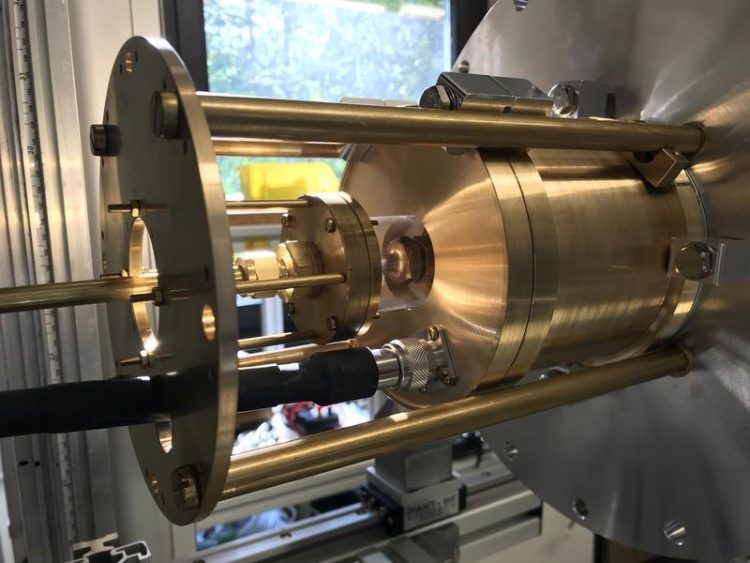Longer satellites lifetime, less space junk

Inductive plasma thruster (IPT). University of Stuttgart / IRS
Earth observation satellites for very low altitudes, smaller, lighter, and cheaper than conventional models: These are the goals of the EU project “DISCOVERER”, in which nine partners from Europe and the US are involved.
For the first time, the new inductive plasma thruster (IPT) was ignited at the Institute of Space Systems (IRS) of the University of Stuttgart.
The novel plasma thruster is intended to solve one of the key problems of the mission: It compensates the aerodynamic drag in very low orbits, thereby extending the satellites’ lifetime.
The thruster is based on helicon waves and it is equipped with an antenna used in the medical field.
Satellite missions in the so-called “Very Low Earth Orbit”, i.e. at low altitudes of up to 400 km, enable new methods of Earth observation, such as the permanent measurement of the Earth’s gravity field using small and inexpensive satellites.
However, there is still a relatively high aerodynamic drag at these altitudes due to the residual atmosphere. Because of the aerodynamic drag, the satellite gets slower over time, which allows gravity to draw it closer to the Earth until it enters the Earth’s atmosphere and demises. Depending on the altitude, the mission would end within a period of days to a few months.
To solve the lifetime limitation problem and to open up new significantly improved methods of Earth observation, a research group at IRS of the University of Stuttgart has been developing an “Atmosphere-Breathing Electric Propulsion System” (ABEP) since 2014 capable to compensate such drag.
The system collects the atmospheric particles, which are responsible for drag, from the residual atmosphere in front of the satellite and uses them as a propellant.
This has the advantage that the satellite does not need to carry an on-board propellant, as it is supplied by the residual atmosphere and by electricity generated by photovoltaic panels.
The electrical energy converts the propellant into plasma, which is accelerated to generate thrust. Conventional propulsion systems require electrodes or grids for this purpose, which are sensitive to the aggressive oxygen.
Others work with an equally sensitive neutralizer, a device that prevents the satellite from becoming electrically charged and thereby attracting the ions back toward the satellite, which would cancel the thrust.
The IRS of the University of Stuttgart has now developed for the first time an Atmosphere-Breathing Electric Propulsion (ABEP) system that does not need these “tools”. The ABEP system is composed of an intake and an RF thruster, the inductive plasma thruster (IPT). The IPT is based on so-called helicon waves, i.e. low-frequency electromagnetic waves. With this advanced physical principle, the plasma is ignited by an antenna and accelerated to generate thrust.
The IPT developed by the IRS uses for the first time a so-called cylindrical birdcage antenna, which has its origin in magnetic resonance imaging. The antenna provides electromagnetic mechanisms that accelerate both the ions and the electrons simultaneously. As a result, the antenna has a particularly high degree of efficiency, which the plasma jet has proven in initial tests.
The commissioning the inductive plasma thruster is a breakthrough that has several advantages: the thruster can deal with variable propellant flows and compositions and thus takes into account that there are no uniform conditions in the atmosphere. In addition, it can also be operated with the aggressive propellants from the thermosphere, such as atomic oxygen, without any problems. Ions and electrons are accelerated rapidly and simultaneously to generate thrust; a neutralizer is therefore not required.
This project has received funding from the European Union’s Horizon 2020 research and innovation programme under grant agreement No. 737183. This reflects only the author’s view and the European Commission is not responsible for any use that may be made of the information it contains.
Priv.-Doz. Dr. Georg Herdrich, Francesco Romano, University of Stuttgart, Institute of Space Systems, phone: +49 (0)711/685 62412, -62399
email: herdrich@irs.uni-stuttgart.de, romano@irs.uni-stuttgart.de
F. Romano, G. Herdrich, et al. “Inductive Plasma Thruster (IPT) for an Atmosphere-Breathing Electric Propulsion System: Design and Set in Operation”, 36th International Electric Propulsion Conference (IEPC), Vienna, Austria, September 2019, IEPC-2019-A488.
http://electricrocket.org/2019/488.pdf
Media Contact
More Information:
http://www.uni-stuttgart.de/All latest news from the category: Physics and Astronomy
This area deals with the fundamental laws and building blocks of nature and how they interact, the properties and the behavior of matter, and research into space and time and their structures.
innovations-report provides in-depth reports and articles on subjects such as astrophysics, laser technologies, nuclear, quantum, particle and solid-state physics, nanotechnologies, planetary research and findings (Mars, Venus) and developments related to the Hubble Telescope.
Newest articles

How marine worms regenerate lost body parts
The return of cells to a stem cell-like state as the key to regeneration. Many living organisms are able to regenerate damaged or lost tissue, but why some are particularly…

Nano-scale molecular detective
New on-chip device uses exotic light rays in 2D material to detect molecules. Researchers have developed a highly sensitive detector for identifying molecules via their infrared vibrational “fingerprint”. Published in Nature…

Novel CAR T-cell therapy
… demonstrates efficacy and safety in preclinical models of HER2-positive solid tumors. The p95HER2 protein is found expressed in one third of HER2+ tumors, which represent 4% of all tumors….



